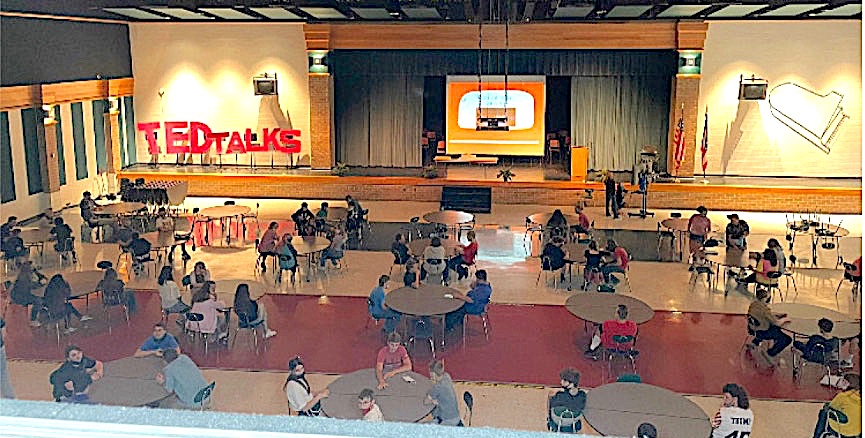How Your Students Can Create TED-Style Talks
By Lauren Buell
 Several years ago my ELA teammates and I were approached by the superintendent and asked to create a new tradition for eighth-grade students transitioning into high school. They would research, propose, and present their own TED-style Talks in the final quarter.
Several years ago my ELA teammates and I were approached by the superintendent and asked to create a new tradition for eighth-grade students transitioning into high school. They would research, propose, and present their own TED-style Talks in the final quarter.
Having only watched a few TED Talks online, I wasn’t sure where to begin, but with a lot of research and practice (by crafting my own presentations each year), I’m proud to say that this has become a meaningful rite of passage for eighth graders at the end of their last middle school year.
The end of eighth grade is a major transitional period for adolescents. They’re both nervous and excited about entering into the next stage of their lives, and they have enough life experience to be able to reflect upon what they’ve learned so far and to share it with their peers.
We ask students to also think of how various audience members can relate to concepts in their presentations. For example, this past year one student presentation was titled “My Unique Perspective on Sympathy” in which the topic was centered around an analogical analysis of toxicity in relationships explored in Shel Silverstein’s children’s book The Giving Tree and how that can translate into failing to set healthy boundaries in friendships and other relationships.
Not only was this presentation relatable to all peers, but it was universal to the teachers and administrators in the room who witnessed the presentation. It showed that all literature is relevant depending on the level in which you make connections and your own life experiences.
A quick glimpse at the process

They can choose to present on whatever topic they feel they want to share after careful reflection of their life experiences so far, whether they want to focus more on wisdom or knowledge, or both.
Student talks have ranged from “How to Cope with Divorce” to “What Working on Car Engines Has Taught Me About Life” to “Middle School Microcosm,” a talk directed towards looking at learning in each class as a metaphorical representation of what students will experience later on in life.
All students perform talks in the classroom. Then a small group of students who have fully met our guidelines present on the big stage on the last day of school. Students organize the production backstage, and we facilitate, but ultimately it’s “their show.”
Students across the grades view the talks and have become accustomed to looking forward to their eighth-grade year and presenting their own knowledge and wisdom on the stage.
What it looks like in our classrooms
Below are some resources we have used in the past. The unit has typically taken about three weeks total. The teacher also models throughout each step of the process, presents a TED Talk of their own, and reflects with students throughout the coaching process and the last steps before performances.
We like to teach in phases to give students enough time to analyze other strong TED Talks and create their own list of “Mentor Texts.” Teachers also model this, and we present our TED-style talks first. I can say that, without a doubt, each year I have created a new topic and presented has truly made my life better.
Just using resources and allowing students a platform is not enough. Modeling the process and experiencing the same feelings of self-exploration and expression as the students helps create an environment where students are still scared of presenting, but they’re also excited to do so.
Overview of the Process
Phase 1: Students analyze mentor text TED Talks (planting “seeds” of ideas in their Writer’s Notebooks) for topic, thesis, purpose, specific targeted audience, and possible ideas that could stem from the mentor talks. Mentor texts are intentionally chosen to analyze presenters with various backgrounds, disciplines, purposes, and ideas.
Phase 2: Students analyze another short set of talks where they look for the presenter’s use of Greek appeals to the audience – ethos, logos, and pathos – as well as elements we analyzed while planting seeds in our Writer’s Notebook earlier in the school year.
Phase 3: Students submit a proposal to be approved by the teacher and begin using “The Process” of various parts of their TED Talk (Greek Appeals, Hook, “Body,” The Power of Three, Storytelling with a call to action, or a Poetry Performance originally written).
Phase 4: “The Process” is modeled each day students are writing, and coaching takes place during Independent Work Time (one-on-one instruction and feedback).
As audience members, peers also analyze their peers’ talks and jot down at least one way they can apply the thesis of the talks they observe in their own lives and/or in the community moving forward (ideas for United Service Day, service projects, etc.). They also reflect on their own performances.
Phase 5: The last phase for students is to make a “pledge” to themselves about how they can incorporate the thesis of their presentation into the next year of their life with tangible, reasonable goals. We added this feature to the year based on a reflection of how our own talks have influenced us positively each year we’ve taught and also participated.
Not only has this become a meaningful project for students, it has become a meaningful experience for us. The process means something to us, personally, and to see that trickle down into students, especially in such a symbolic moment, is powerful.
Beyond eighth grade
The TED-Talk mini-curriculum also translates well into high school. In addition to teaching middle school ELA, I also direct the high school marching band and intentionally choose leadership meetings, activities, and even song choices around the concepts of the presentations students shared in the eighth grade.
The band students help to construct the show, and we dive (just a little bit) into the lyrics of what they’re playing. This helps to build a stronger community of learners that bridges the gap between middle and high school.
When students begin to see relevance and meaning in anything they do, whether it’s a challenging personal life experience or a challenging piece of music, their motivation skyrockets. And they can translate the same skills of perseverance, reflection and managing performance anxiety into a sense of pride about what they have accomplished because it was challenging and showed an inner strength that can carry over when they face any obstacle.
Students (and teachers) learn that anxiety and struggle is a certainty in life, but learning to harness these emotions in a healthy way by sharing their journey with others shows us that no experience is wasted unless we allow it to be.
Lauren Buell attended Ohio University where she earned her bachelor’s degree in English Language Arts Education, grades 7-12. She has been teaching for 13 years in the middle school classroom. Lauren began her career in Estill, South Carolina and taught in Beaufort, South Carolina for a total of five years before moving back home to Ohio. She has worked at Graham Middle School as an ELA teacher in St. Paris, Ohio for the last eight years, and she also serves as the high school marching band director.




































Ms. Buell: Our district is hosting a TedTalk event later in the semester, which means we are beginning the journey now. Can you give me some insight as to the time allotment for each phase of the process?
Sure! We do have 90-minute class periods with a double block for ELA classes, so the timeline may need adapting depending on class periods, but here is a rough estimate of the allotted time we’ve used for each stage.
Phase 1 and 2: 1 week
Phase 3: 1-2 days with direct feedback and individual coaching and conferences as needed.
Phase 4: 5-7 class periods (1 week)
Phase 5: 1-2 days during presentations
Hi, Any chance I can get a copy of this project so that I could do it with my students? We have very limited time but would like to do something similar.
Hi there! This project takes several weeks, so I have lots of different resources. Is there something in particular you’re looking for?
Thanks for the quick reply! I think I would like it to be a final project including a presentation based on argumentative essays they are currently writing. However, if they get overwhelmed they will shut down. So honestly I am not sure what to include.
I start off with Phase 1, which is analyzing the use of rhetoric in mentor texts, so I’d recommend starting that way. Rhetoric is a great tool for argumentative writing, so that would be a good start! Then, they could analyze the use of rhetoric in their argumentative pieces to help use the analysis form to create their own if they’re limited on time. My full unit takes about 3-4 weeks total, as it’s more of a mini-capstone based on their life experience so far. Feel free to send an email, and I can share that form your way! buelll@grahamlocalschools.org